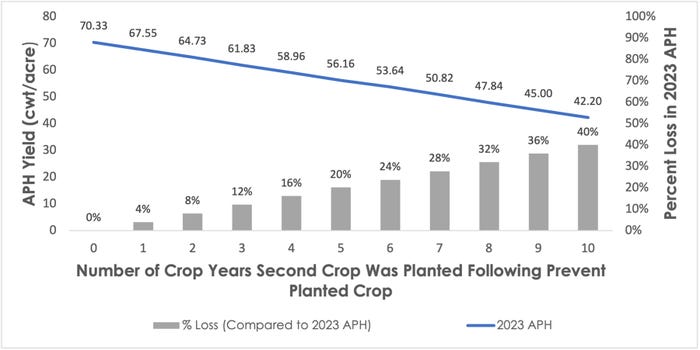
Commercial row crop production faces many risks that may result in actual harvest yields falling below yield expectations. Historical data from the USDA-RMA Cause of Loss indicate excess moisture and drought are the top weather risks faced by producers nationwide.
In the Midsouth, excess moisture early in the season is a prevalent risk affecting planting decisions (USDA-RMA, 2023). Producers with wet fields may be forced to plant later than anticipated, plant an alternative crop (e.g., soybeans), or forego planting altogether.
If a producer is forced to forego planting altogether, not only will the producer experience the loss in revenue expected from harvesting the crop, but they also bear the cost associated with land preparation prior to the prevented planting.
The prevented planting provision of federal crop insurance helps producers to reduce the financial uncertainty of navigating early season planting risks.
Sunk cost
The prevented planting provision is unlike other crop insurance provisions since indemnities paid to producers are not intended to cover yield losses, but rather the sunk cost required to have land prepared for planting and, to a certain extent, the cost of invested capital needed for crop production.
An insured producer is eligible to make a prevented planting claim if they are unable to plant a crop before the final planting date, which varies across counties and crops (USDA-RMA, 2021a).
A producer will receive 100% of the prevented planting indemnity on the first insured crop if a second crop is not planted or if a cover crop is planted but not harvested for grain or seed. A producer may also receive the full prevented planting indemnity if the subsequent cover crop is grazed, cut for silage, hayed, or baled (USDA-RMA, 2021b).
Importantly, the prevented planting indemnity itself does not affect a producer’s Actual Production History (APH), the 10-year average of an insured unit’s yields. However, the APH will be adversely impacted if a second crop is planted, grown, and harvested following the prevented planting claim of a first insured crop.
Second crop
If the producer decides to plant a second crop after the late planting period of the first crop, the prevented planting indemnity is reduced to 35% of the full prevented planting payment, and the producer receives a yield of 60% of APH of the first crop to be included in future APH calculations (USDA-RMA, 2021a).
Using long grain rice as an example, Figure 1 demonstrates how planting a second crop following a prevented planting claim can affect a producer’s APH over time.
Beginning with the Jackson County, Ark., 2023 average APH for rice of 70.33 cwt/acre, Figure 1 shows that if insured rice is prevented from planting and a second crop for harvest is planted, the unit’s APH will be reduced by 4%. Figure 1 further shows that consecutive years of planting a second crop following prevented planting can have a compounding effect.
If a producer planted a second crop in 2 of the previous crop years considered in the APH calculation, the producer’s 2023 APH is reduced by 8%. After planting a second crop in 4 of the historical crop years used in the APH calculation, the reduction in the 2023 APH will be as much as 16%.
If this choice was made in 10 consecutive historical years, the unit’s APH would be reduced to nearly half its original value. In addition to losing insurable yield levels, a declining APH will impact insurance premium rates.
Special provisions exist for counties with approved double crop practices, and in certain cases multiple year prevented planting claims may be limited. Always confirm your choice options and consequences with your crop insurance agent.

Figure 1: Percent loss in APH rice yields after planting a second crop following prevented planting
About the Author(s)
You May Also Like




